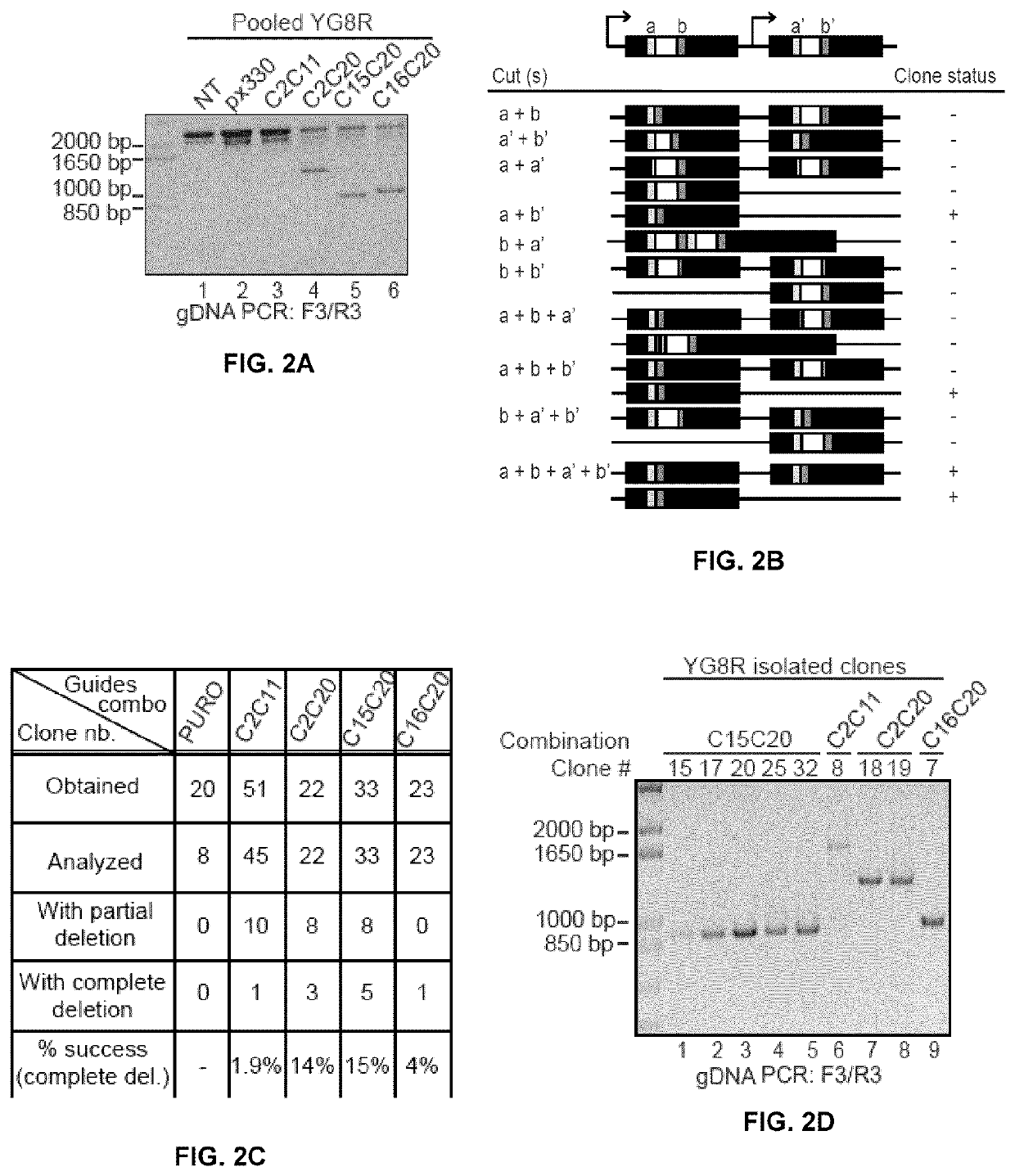Crispr-based treatment of friedreich ataxia
a technology of friedreich ataxia and fxn gene, which is applied in the field of fxn gene endogenous modification, can solve the problems of oxidative stress, inability to detect fxn gene, etc., and achieves the effects of increasing fxn protein expression, reducing off-target mutation rate, and increasing fxn expression above the baseline level of fxn expression
- Summary
- Abstract
- Description
- Claims
- Application Information
AI Technical Summary
Benefits of technology
Problems solved by technology
Method used
Image
Examples
example 1
Materials and Methods
[0135]DNA constructs. Plasmids used in this study included the following: px330 as px330-U6-Chimeric_BB-CBh-hSpCas9 (Addgene plasmid #42230)(43), pxGFP or pxPuro as pSpCas9(BB)-2A-GFP or Puro (Addgene plasmids #48138 / 48139)(44) and px601 as px601-AAV-CMV::NLS-SaCas9-NLS-3xHA-bGHpA;U6::Bsal- gRNA (Addgene plasmid #61591) (31) which were provided by Feng Zhang (Department of Genetics, Harvard Medical School, Boston, Mass., USA). Plasmids used also included the pRGEN-CMV-CjCas9 plasmid (Addgene #89752) the pU6-Cj- gRNA plasmid (Addgene #89753), which were provided by Seokjoon Kim (ToolGen, Geumcheon-gu, Seoul, South Korea). Others plasmids included a recombinant AAV vector backbone modified from the pAAV_TALE-TF (VP64)-BB_V3 (Addgene#42581), provide by Feng Zhang (Department of Genetics, Harvard Medical School, Boston, Mass., USA). Oligonucleotides coding for guide RNAs were synthetized by Integrated DNA Technologies (IDT inc., Coralville, Iowa) and cloned into Bbs...
example 2
Identification of gRNA Pairs Targeting Sequences Upstream and Downstream GAA TRINUCLEOTIDE Repeats
[0154]gRNAs targeting sequences located upstream (5′) and downstream (3′) of the GAA trinucleotide repeats in intron 1 of the FXN gene (NG_008845) were designed. Sequences adjacent to the S. pyogenes NGG PAM were first identified (FIG. 1A and Table 5) and 20 nts oligonucleotides targeting sequences located 5′ of the PAMs were prepared and cloned in an expression vector (px330, and / or pxPuro and / or pxGFP, Addgene; see Example 1) under the control of a RNA polymerase (pol) III U6 promoter. Vectors also encoded the SpCas9 protein under the control of a RNA pol II promoter (CBh).
[0155]The rescued YG8 (YG8R) mouse model is model system to study FRDA (24-26) which has been known for many years. The YG8R mouse genome contains 2 null mouse FXN genes but also 2 copies in tandem, of a FXN transgene obtained from an FRDA patient. These human transgenes contain respectively 82 and 190 GAA repeats i...
example 3
Deletion of the FXN Intronic GAA Repeats in YG8R Fibroblasts
[0157]Some gRNA pairs were selected and were cloned into pxPuro, which shares similarities with px330 but contains a puromycin gene for selection. These new plasmids were retested in YG8R cells (FIG. 2A). Following detection of the corrected PCR amplicon in the puromycin resistant cell population, cells were amplified as individual clones. Since the human FRDA FXN transgene is in tandem copies in YG8R cells, there are several possible rearrangements following deletions with a pair of gRNAs, as shown in FIG. 2B. Positive clones are described as clones with a complete deletion of the GAA repeats in both tandem copies, i.e., the amplicons obtained with primers F3 and R3 did not contain the 2070 and the 2394 bp bands. Pair of gRNAs C2C20 and 015C20 gave the highest percentages of success (14% and 15% respectively) of complete deletions (FIG. 2C). Partial deletion status was attributed when one of the GAA band was still present ...
PUM
| Property | Measurement | Unit |
|---|---|---|
| thermal melting point | aaaaa | aaaaa |
| pH | aaaaa | aaaaa |
| pH | aaaaa | aaaaa |
Abstract
Description
Claims
Application Information
 Login to View More
Login to View More - R&D
- Intellectual Property
- Life Sciences
- Materials
- Tech Scout
- Unparalleled Data Quality
- Higher Quality Content
- 60% Fewer Hallucinations
Browse by: Latest US Patents, China's latest patents, Technical Efficacy Thesaurus, Application Domain, Technology Topic, Popular Technical Reports.
© 2025 PatSnap. All rights reserved.Legal|Privacy policy|Modern Slavery Act Transparency Statement|Sitemap|About US| Contact US: help@patsnap.com



